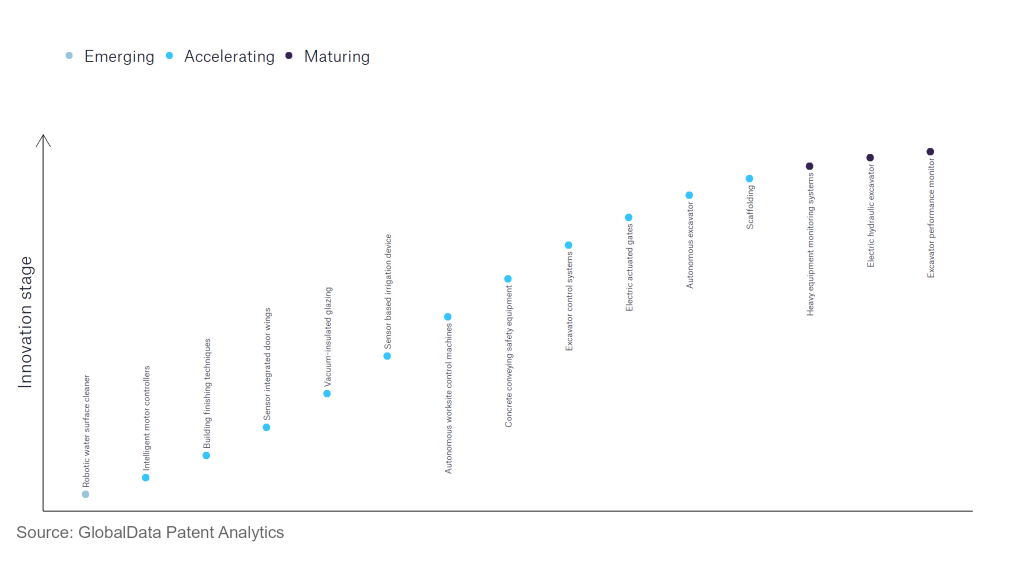The construction industry continues to be a hotbed of innovation, with activity driven by an increased focus on environmental sustainability, workplace safety and circular construction, and the growing importance of technologies such as robotics and the Internet-of-Things (IoT). In the last three years alone, there have been over 248,000 patents filed and granted in the construction industry, according to GlobalData’s report on Robotics in Construction: Vacuum-insulated glazing. Buy the report here.
However, not all innovations are equal and nor do they follow a constant upward trend. Instead, their evolution takes the form of an S-shaped curve that reflects their typical lifecycle from early emergence to accelerating adoption, before finally stabilising and reaching maturity.
Identifying where a particular innovation is on this journey, especially those that are in the emerging and accelerating stages, is essential for understanding their current level of adoption and the likely future trajectory and impact they will have.
80+ innovations will shape the construction industry
According to GlobalData’s Technology Foresights, which plots the S-curve for the construction industry using innovation intensity models built on over 179,000 patents, there are 80+ innovation areas that will shape the future of the industry.
Within the emerging innovation stage, robotic water surface cleaners are the disruptive technology that is in the early stage of application and should be tracked closely. Intelligent motor controllers, building finishing techniques, and sensor-integrated door wings are some of the accelerating innovation areas, where adoption has been steadily increasing. Among maturing innovation areas are heavy equipment monitoring systems and electric hydraulic excavator, which are now well established in the industry.
Innovation S-curve for robotics in the construction industry

Vacuum-insulated glazing is a key innovation area in robotics
Vacuum-insulated glazing, or VIG, is a method to improve the thermal performance of glazed windows, and thus improve the energy efficiency of buildings. As opposed to conventional glazing methods, which use a number of separate panes of glass within a sealed frame, vacuum-insulated glazing retains heat through the use of a vacuum between the panes of glass.
GlobalData’s analysis also uncovers the companies at the forefront of each innovation area and assesses the potential reach and impact of their patenting activity across different applications and geographies. According to GlobalData, there are 60 companies, spanning technology vendors, established construction companies, and up-and-coming start-ups engaged in the development and application of vacuum-insulated glazing.
Key players in vacuum-insulated glazing – a disruptive innovation in the construction industry
‘Application diversity’ measures the number of different applications identified for each relevant patent and broadly splits companies into either ‘niche’ or ‘diversified’ innovators.
‘Geographic reach’ refers to the number of different countries each relevant patent is registered in and reflects the breadth of geographic application intended, ranging from ‘global’ to ‘local’.
Patent volumes related to vacuum-insulated glazing
Source: GlobalData Patent Analytics
Leading companies in the development of vacuum-insulated glazing include Panasonic, a producer of consumer electronics, construction technology, and home and building solutions. Panasonic’s key innovations relating to vacuum-insulated glazing include a method for the manufacture of a gas adsorbent to be placed within the vacuum space between two panes of glass. The manufacture of the gas adsorbent includes the preparation of a substrate made of inorganic material, and a liquid containing a getter, and the attachment of the liquid to the substrate. Other leading companies in the space include VKR, a manufacturer and developer of building products. VKR’s key patents include a method for manufacturing a number of thermal treated pane elements for vacuum insulating glass units.
In terms of geographic reach, leading companies include Kingspan Group, a manufacturer of building materials, and Luoyang Landglass Technology, a producer of float sheet glass. In terms of application diversity, leading companies include Protan, a manufacturer of roofing membranes, and Holcim, a building materials producer.
To further understand the key themes and technologies disrupting the construction industry, access GlobalData’s latest thematic research report on Robotics in Construction.
Data Insights
From

The gold standard of business intelligence.
Blending expert knowledge with cutting-edge technology, GlobalData’s unrivalled proprietary data will enable you to decode what’s happening in your market. You can make better informed decisions and gain a future-proof advantage over your competitors.



